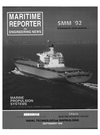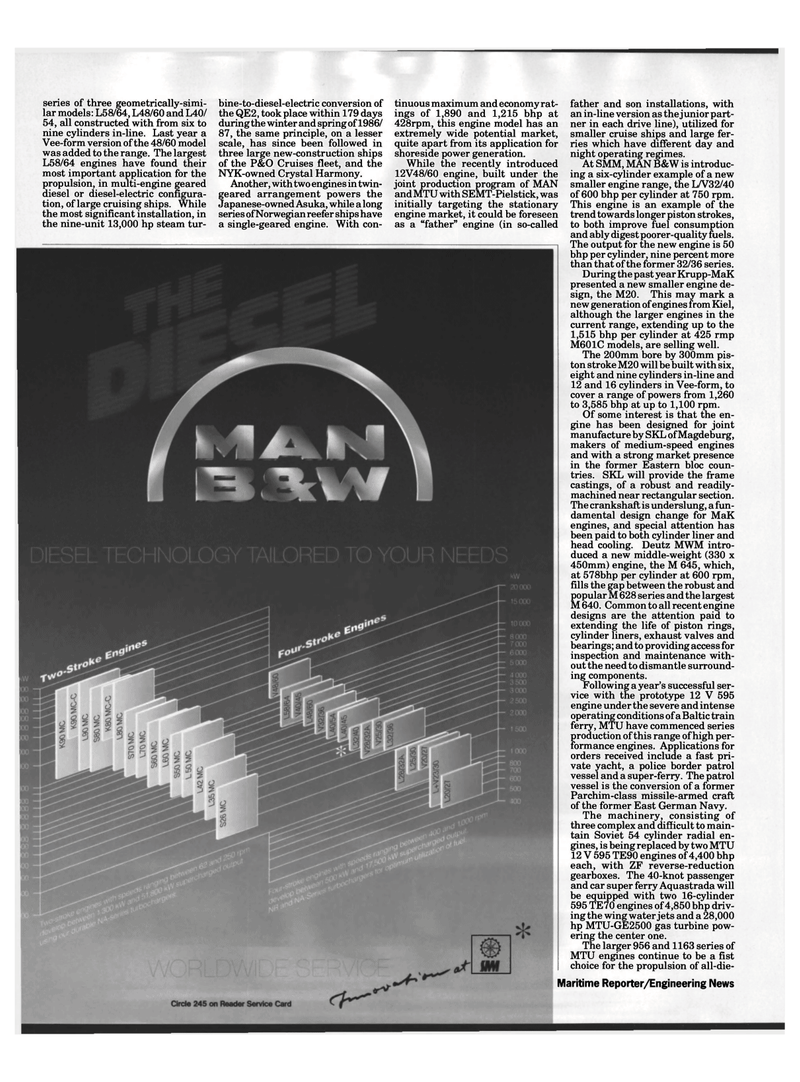
Page 62: of Maritime Reporter Magazine (September 1992)
Read this page in Pdf, Flash or Html5 edition of September 1992 Maritime Reporter Magazine
series of three geometrically-simi- lar models: L58/64, L48/60 and L40/ 54, all constructed with from six to nine cylinders in-line. Last year a
Vee-form version of the 48/60 model was added to the range. The largest
L58/64 engines have found their most important application for the propulsion, in multi-engine geared diesel or diesel-electric configura- tion, of large cruising ships. While the most significant installation, in the nine-unit 13,000 hp steam tur- bine-to-diesel-electric conversion of the QE2, took place within 179 days during the winter and spring of1986/ 87, the same principle, on a lesser scale, has since been followed in three large new-construction ships of the P&O Cruises fleet, and the
NYK-owned Crystal Harmony.
Another, with two engines in twin- geared arrangement powers the
Japanese-owned Asuka, while a long series ofNorwegian reefer ships have a single-geared engine. With con- tinuous maximum and economy rat- ings of 1,890 and 1,215 bhp at 428rpm, this engine model has an extremely wide potential market, quite apart from its application for shoreside power generation.
While the recently introduced 12V48/60 engine, built under the joint production program of MAN and MTU with SEMT-Pielstick, was initially targeting the stationary engine market, it could be foreseen as a "father" engine (in so-called father and son installations, with an in-line version as the junior part- ner in each drive line), utilized for smaller cruise ships and large fer- ries which have different day and night operating regimes.
At SMM, MAN B&W is introduc- ing a six-cylinder example of a new smaller engine range, the L/V32/40 of 600 bhp per cylinder at 750 rpm.
This engine is an example of the trend towards longer piston strokes, to both improve fuel consumption and ably digest poorer-quality fuels.
The output for the new engine is 50 bhp per cylinder, nine percent more than that of the former 32/36 series.
During the past year Krupp-MaK presented a new smaller engine de- sign, the M20. This may mark a new generation of engines from Kiel, although the larger engines in the current range, extending up to the 1,515 bhp per cylinder at 425 rmp
M601C models, are selling well.
The 200mm bore by 300mm pis- ton stroke M20 will be built with six, eight and nine cylinders in-line and 12 and 16 cylinders in Vee-form, to cover a range of powers from 1,260 to 3,585 bhp at up to 1,100 rpm.
Of some interest is that the en- gine has been designed for joint manufacture by SKL of Magdeburg, makers of medium-speed engines and with a strong market presence in the former Eastern bloc coun- tries. SKL will provide the frame castings, of a robust and readily- machined near rectangular section.
The crankshaft is underslung, a fun- damental design change for MaK engines, and special attention has been paid to both cylinder liner and head cooling. Deutz MWM intro- duced a new middle-weight (330 x 450mm) engine, the M 645, which, at 578bhp per cylinder at 600 rpm, fills the gap between the robust and popular M 628 series and the largest
M 640. Common to all recent engine designs are the attention paid to extending the life of piston rings, cylinder liners, exhaust valves and bearings; and to providing access for inspection and maintenance with- out the need to dismantle surround- ing components.
Following a year's successful ser- vice with the prototype 12 V 595 engine under the severe and intense operating conditions of a Baltic train ferry, MTU have commenced series production of this range of high per- formance engines. Applications for orders received include a fast pri- vate yacht, a police border patrol vessel and a super-ferry. The patrol vessel is the conversion of a former
Parchim-class missile-armed craft of the former East German Navy.
The machinery, consisting of three complex and difficult to main- tain Soviet 54 cylinder radial en- gines, is being replaced by two MTU 12 V 595 TE90 engines of4,400 bhp each, with ZF reverse-reduction gearboxes. The 40-knot passenger and car super ferry Aquastrada will be equipped with two 16-cylinder 595 TE70 engines of4,850 bhp driv- ing the wing water jets and a 28,000 hp MTU-GE2500 gas turbine pow- ering the center one.
The larger 956 and 1163 series of
MTU engines continue to be a fist choice for the propulsion of all-die- 64 Maritime Reporter/Engineering News

 61
61

 63
63
